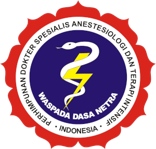Anesthetic Management in Cardiac Sympathetic Denervation
Abstract
Background : This case report discusses anesthetic management of cardiac sympathetic denervation (CSD), with a particular focus on strategies for maintaining optimal perioperative hemodynamic stability.
Case Illustration : A 59-year-old woman diagnosed with dilated cardiomyopathy accompanied by impaired ejection fraction was treated for refractory ventricular tachycardia. She experienced recurrent ventricular tachycardia despite having undergone radiofrequency CA and receiving pharmacologic agents such as beta-blockers and antiarrhythmic drugs. She underwent CSD procedure through video‑assisted thoracoscopic surgery (VATS) approach under general anesthesia. In addition to standard monitoring and invasive blood pressure monitoring, the preparation of an external defibrillator, vasopressors, and inotropic agents were necessary prior to the induction of anesthesia. Intravenous induction agents were administered in small initial doses and increased gradually according to the response of the patient. CSD was performed through a left side sympathetic ganglionectomy using VATS approach. During CSD procedure, patient was placed in supine position to reduce the risk of hemodynamic instability associated with position change to right lateral decubitus and to facilitate cardiopulmonary resuscitation and defibrillation if ventricular tachycardia and/or ventricular fibrillation occur perioperatively. The patient was extubated in the operating room and transferred to ICU safely.
Conclusion: Anesthesiologists must determine the hemodynamic targets to be achieved before inducing patients with dilated cardiomyopathy, so that several things must be appointed including the patient clinical status and the degree of cardiac function, the appropriate monitoring devices and anesthetic agents, and other resources which required to activate the ACLS protocol to maximize perioperative survival.
Keywords
Full Text:
PDFReferences
1. Li M, Huang H. Anesthetic Management of Patients with Dilated Cardiomyopathy Undergoing Noncardiac Surgery. Medicina (B Aires). 2023 Sep 1;59(9):1567.
2. Elsokkari I, Sapp JL. Electrical storm: Prognosis and management. Prog Cardiovasc Dis. 2021 May 1;66:70–9.
3. König S, Schröter T, Borger MA, Bertagnolli L, Nedios S, Darma A, et al. Outcomes following cardiac sympathetic denervation in patients with structural heart disease and refractory ventricular arrhythmia. EP Europace. 2022 Nov 22;24(11):1800–8.
4. Damasceno C, Delgado M, Pinheiro P, Quadros I. Anesthetic management in bilateral video-assisted thoracoscopic sympathectomy for refractory ventricular arrhythmias: A case report. Saudi J Anaesth. 2021 Apr 1;15(2):207.
5. Yadav N, Verma B, Aggarwal P, . R, Chiluka JDK. Anaesthetic Management of a Patient with Dilated Cardiomyopathy and Acute Decompensated Heart Failure. Journal of Clinical and Diagnostic Research. 2022 Jun 1;16(6):UD04–5.
6. Elliott IA, DeJesus M, Dobaria V, Vaseghi M, Ajijola OA, Shivkumar K, et al. Minimally Invasive Bilateral Stellate Ganglionectomy for Refractory Ventricular Tachycardia. JACC Clin Electrophysiol. 2021 Apr 1;7(4):533–5.
7. Pinsky MR, Cecconi M, Chew MS, De Backer D, Douglas I, Edwards M, et al. Effective hemodynamic monitoring. Crit Care. 2022 Dec 1;26(1).
8. Dede Ş, Demir ZA, Balcı E. Anesthesia induction regimens may affect QT interval in cardiac surgery patients: A randomized-controlled trial. Turkish Journal of Thoracic and Cardiovascular Surgery. 2022;30(3):354.
9. Sun TT, Chen KX, Tao Y, Zhang GW, Zeng L, Lin M, et al. Effect of flow-optimized pressure control ventilation-volume guaranteed (PCV-VG) on postoperative pulmonary complications: a consort study. J Cardiothorac Surg. 2024 Dec 1;19(1):425.
Refbacks
- There are currently no refbacks.








